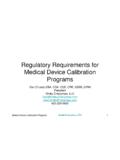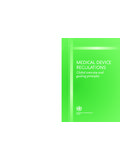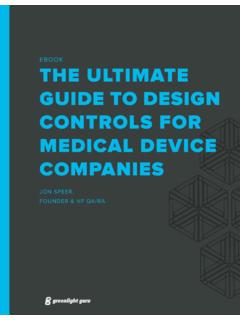Transcription of CHAPTER 23 STERILE MEDICAL DEVICE PACKAGE …
1 23 STERILE MEDICAL DEVICEPACKAGE DEVELOPMENTP atrick J. NolanDDL Inc., Eden Prairie, HISTORY PACKAGE OF A PACKAGE PACKAGE TYPES SHELF LIFE STUDIES PACKAGING MATERIALS PACKAGE VALIDATION TESTING CHAPTER provides an overview of the process of designing and developing a PACKAGE system fora MEDICAL DEVICE . A comprehensive discussion of this subject is beyond the scope of this CHAPTER ;however, numerous references are provided for further detail and study of the subject.
2 The informa-tion provided in this CHAPTER is a compilation from the references cited as well as from the experiencesof the author in developing PACKAGE systems for MEDICAL of a standard for the process of designing and developing a PACKAGE for terminallysterilized MEDICAL devices is essential to the overall endeavor of marketing a STERILE DEVICE in theinternational and domestic communities. It is incumbent upon the MEDICAL DEVICE manufacturer toensure that a safe, reliable, and fully functional DEVICE arrives at the point of end use.
3 This assuranceis complicated by the fact that the PACKAGE must maintain its barrier integrity throughout its intendedshelf life and through the rigors of manufacture and shipping and handling. The total productdevelopment effort must include the packaging design process and encompasses the PACKAGE design,manufacturing process, sterilization process, and distribution environment effects. The intended ster-ilization method and the intended use, shelf life, transport, and storage all influence the packagedesign and choice of packaging issue of developing a PACKAGE system seems uncomplicated and elementary.
4 In actuality, thepackage process is complicated by the fact that DEVICE packages must allow effective sterilization oftheir contents by a wide array of methods; therefore the materials must be compatible with thesterilization method. Consequently, the PACKAGE must provide a consistent and continuous barrier toenvironmental microorganisms and bacteria so as to maintain product sterility. The PACKAGE must bedesigned to prevent product damage and loss of functionality from the dynamic hazards of shock andvibration inherent in the distribution environment.
5 In addition, the manufacturer must havedocumented evidence that the performance of the PACKAGE system is not adversely affected over interactions of the materials and product, combined with the processes required to bring theproduct to its end use, influence the PACKAGE design and manufacturing of the finished from Digital Engineering Library @ McGraw-Hill ( )Copyright 2004 The McGraw-Hill Companies. All rights use is subject to the Terms of Use as given at the : STANDARD HANDBOOK OF BIOMEDICAL ENGINEERING AND OF MEDICAL devices AND DIAGNOSTIC INSTRUMENTATIONThe importance of packaging to the implementation of a MEDICAL DEVICE is illustrated in a speech byGeorge Brdlik in 1982 that is no less true today.
6 Brdlik stated:Packaging is too often neglected as an important characteristic of a MEDICAL DEVICE . When STERILE MEDICAL devices areinvolved, deficient packaging can cause the following problems: Increased risk of patient infection if product sterility is compromised by defective seals, pinholes fragile packag-ing materials, or packaging which shreds, delaminates, or tears upon opening. Hampering of a surgical procedure because of difficulties in product identification or aseptic transfer, or if aproduct selected for use must be replaced because the PACKAGE is either initially defective or damaged uponopening.
7 Increased hospital costs due to discarded products or excessive storage space requirements Increased manufacturing costs for refund/replacement of damaged products and recall of products with potentiallycompromised sterility or essence, poor packaging can transform the best, safest, and most economical MEDICAL DEVICE into an inferior, unsafe,and expensive CHAPTER will provide a systematic and standard approach to developing a comprehensive packagesystem that meets regulatory hurdles and ensures a high degree of confidence that the STERILE medicaldevice product will meet its performance specifications at the point of end use.
8 These elementsinclude: Selection of materials Design of the PACKAGE Process validation Final PACKAGE design validationAll of these elements must be combined to produce a PACKAGE system that meets regulatory, industry,and consumer s regulatory burden for validating the manufacturing process and PACKAGE system has becomesignificant and considerable. It was started in 1938 with the amended Food and Drug Act of 1906 inwhich MEDICAL devices were first regulated, and then progressed to the Quality System Regulation(QSR)
9 , which specifies the requirements for components, DEVICE master record, and environmentalcontrols, to name a is appropriate to present a brief history of how the MEDICAL DEVICE industry became regulatedand how eventually the FDA recognized the importance of the PACKAGE as an integral part, and in facta component, of the MEDICAL DEVICE . As mentioned earlier, the Food and Drug Administration beganregulating MEDICAL devices in 1938. At that time, the Federal Food, Drug, and Cosmetic Act extendedthe FDA s legal authority to control foods and drugs and bestowed the agency with new legal powersover cosmetics and MEDICAL devices .
10 However, the act was limited in scope in that the regulatoryactions could only be taken after a DEVICE was introduced into interstate commerce, and only after thedevice was found to be adulterated or misbranded. Surprisingly, the burden was on the governmentto provide evidence of violation of the act. In addition, the 1938 act could not prevent theintroduction and marketing of quack MEDICAL devices . However, there was also an explosion oflegitimate and sophisticated new devices using postwar biotechnology.





